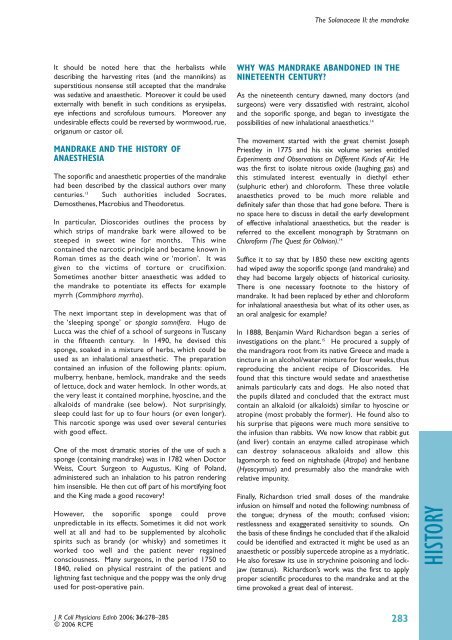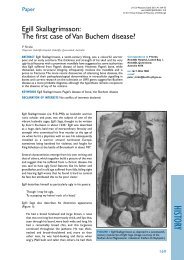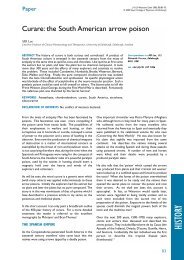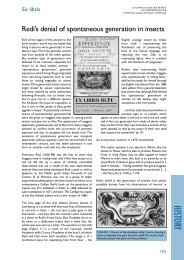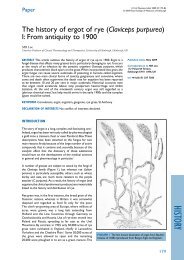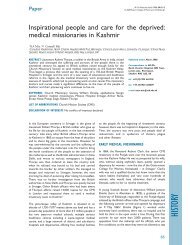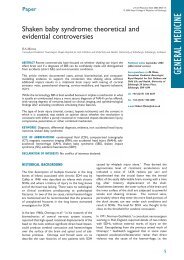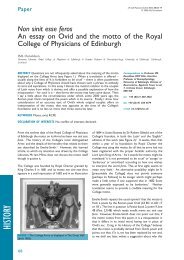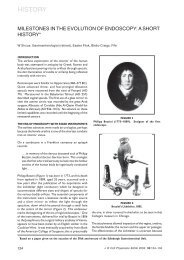The Solanaceae II: The mandrake (Mandragora officinarum); in ...
The Solanaceae II: The mandrake (Mandragora officinarum); in ...
The Solanaceae II: The mandrake (Mandragora officinarum); in ...
You also want an ePaper? Increase the reach of your titles
YUMPU automatically turns print PDFs into web optimized ePapers that Google loves.
It should be noted here that the herbalists while<br />
describ<strong>in</strong>g the harvest<strong>in</strong>g rites (and the mannik<strong>in</strong>s) as<br />
superstitious nonsense still accepted that the <strong>mandrake</strong><br />
was sedative and anaesthetic. Moreover it could be used<br />
externally with benefit <strong>in</strong> such conditions as erysipelas,<br />
eye <strong>in</strong>fections and scrofulous tumours. Moreover any<br />
undesirable effects could be reversed by wormwood, rue,<br />
origanum or castor oil.<br />
MANDRAKE AND THE HISTORY OF<br />
ANAESTHESIA<br />
<strong>The</strong> soporific and anaesthetic properties of the <strong>mandrake</strong><br />
had been described by the classical authors over many<br />
centuries. 13 Such authorities <strong>in</strong>cluded Socrates,<br />
Demosthenes, Macrobius and <strong>The</strong>odoretus.<br />
In particular, Dioscorides outl<strong>in</strong>es the process by<br />
which strips of <strong>mandrake</strong> bark were allowed to be<br />
steeped <strong>in</strong> sweet w<strong>in</strong>e for months. This w<strong>in</strong>e<br />
conta<strong>in</strong>ed the narcotic pr<strong>in</strong>ciple and became known <strong>in</strong><br />
Roman times as the death w<strong>in</strong>e or ‘morion’. It was<br />
given to the victims of torture or crucifixion.<br />
Sometimes another bitter anaesthetic was added to<br />
the <strong>mandrake</strong> to potentiate its effects for example<br />
myrrh (Commiphora myrrha).<br />
<strong>The</strong> next important step <strong>in</strong> development was that of<br />
the ‘sleep<strong>in</strong>g sponge’ or spongia somnifera. Hugo de<br />
Lucca was the chief of a school of surgeons <strong>in</strong> Tuscany<br />
<strong>in</strong> the fifteenth century. In 1490, he devised this<br />
sponge, soaked <strong>in</strong> a mixture of herbs, which could be<br />
used as an <strong>in</strong>halational anaesthetic. <strong>The</strong> preparation<br />
conta<strong>in</strong>ed an <strong>in</strong>fusion of the follow<strong>in</strong>g plants: opium,<br />
mulberry, henbane, hemlock, <strong>mandrake</strong> and the seeds<br />
of lettuce, dock and water hemlock. In other words, at<br />
the very least it conta<strong>in</strong>ed morph<strong>in</strong>e, hyosc<strong>in</strong>e, and the<br />
alkaloids of <strong>mandrake</strong> (see below). Not surpris<strong>in</strong>gly,<br />
sleep could last for up to four hours (or even longer).<br />
This narcotic sponge was used over several centuries<br />
with good effect.<br />
One of the most dramatic stories of the use of such a<br />
sponge (conta<strong>in</strong><strong>in</strong>g <strong>mandrake</strong>) was <strong>in</strong> 1782 when Doctor<br />
Weiss, Court Surgeon to Augustus, K<strong>in</strong>g of Poland,<br />
adm<strong>in</strong>istered such an <strong>in</strong>halation to his patron render<strong>in</strong>g<br />
him <strong>in</strong>sensible. He then cut off part of his mortify<strong>in</strong>g foot<br />
and the K<strong>in</strong>g made a good recovery!<br />
However, the soporific sponge could prove<br />
unpredictable <strong>in</strong> its effects. Sometimes it did not work<br />
well at all and had to be supplemented by alcoholic<br />
spirits such as brandy (or whisky) and sometimes it<br />
worked too well and the patient never rega<strong>in</strong>ed<br />
consciousness. Many surgeons, <strong>in</strong> the period 1750 to<br />
1840, relied on physical restra<strong>in</strong>t of the patient and<br />
lightn<strong>in</strong>g fast technique and the poppy was the only drug<br />
used for post-operative pa<strong>in</strong>.<br />
J R Coll Physicians Ed<strong>in</strong>b 2006; 36:278–285<br />
© 2006 RCPE<br />
<strong>The</strong> <strong>Solanaceae</strong> <strong>II</strong>: the <strong>mandrake</strong><br />
WHY WAS MANDRAKE ABANDONED IN THE<br />
NINETEENTH CENTURY?<br />
As the n<strong>in</strong>eteenth century dawned, many doctors (and<br />
surgeons) were very dissatisfied with restra<strong>in</strong>t, alcohol<br />
and the soporific sponge, and began to <strong>in</strong>vestigate the<br />
possibilities of new <strong>in</strong>halational anaesthetics. 14<br />
<strong>The</strong> movement started with the great chemist Joseph<br />
Priestley <strong>in</strong> 1775 and his six volume series entitled<br />
Experiments and Observations on Different K<strong>in</strong>ds of Air. He<br />
was the first to isolate nitrous oxide (laugh<strong>in</strong>g gas) and<br />
this stimulated <strong>in</strong>terest eventually <strong>in</strong> diethyl ether<br />
(sulphuric ether) and chloroform. <strong>The</strong>se three volatile<br />
anaesthetics proved to be much more reliable and<br />
def<strong>in</strong>itely safer than those that had gone before. <strong>The</strong>re is<br />
no space here to discuss <strong>in</strong> detail the early development<br />
of effective <strong>in</strong>halational anaesthetics, but the reader is<br />
referred to the excellent monograph by Stratmann on<br />
Chloroform (<strong>The</strong> Quest for Oblivion). 14<br />
Suffice it to say that by 1850 these new excit<strong>in</strong>g agents<br />
had wiped away the soporific sponge (and <strong>mandrake</strong>) and<br />
they had become largely objects of historical curiosity.<br />
<strong>The</strong>re is one necessary footnote to the history of<br />
<strong>mandrake</strong>. It had been replaced by ether and chloroform<br />
for <strong>in</strong>halational anaesthesia but what of its other uses, as<br />
an oral analgesic for example?<br />
In 1888, Benjam<strong>in</strong> Ward Richardson began a series of<br />
<strong>in</strong>vestigations on the plant. 15 He procured a supply of<br />
the mandragora root from its native Greece and made a<br />
t<strong>in</strong>cture <strong>in</strong> an alcohol/water mixture for four weeks, thus<br />
reproduc<strong>in</strong>g the ancient recipe of Dioscorides. He<br />
found that this t<strong>in</strong>cture would sedate and anaesthetise<br />
animals particularly cats and dogs. He also noted that<br />
the pupils dilated and concluded that the extract must<br />
conta<strong>in</strong> an alkaloid (or alkaloids) similar to hyosc<strong>in</strong>e or<br />
atrop<strong>in</strong>e (most probably the former). He found also to<br />
his surprise that pigeons were much more sensitive to<br />
the <strong>in</strong>fusion than rabbits. We now know that rabbit gut<br />
(and liver) conta<strong>in</strong> an enzyme called atrop<strong>in</strong>ase which<br />
can destroy solanaceous alkaloids and allow this<br />
lagomorph to feed on nightshade (Atropa) and henbane<br />
(Hyoscyamus) and presumably also the <strong>mandrake</strong> with<br />
relative impunity.<br />
F<strong>in</strong>ally, Richardson tried small doses of the <strong>mandrake</strong><br />
<strong>in</strong>fusion on himself and noted the follow<strong>in</strong>g: numbness of<br />
the tongue; dryness of the mouth; confused vision;<br />
restlessness and exaggerated sensitivity to sounds. On<br />
the basis of these f<strong>in</strong>d<strong>in</strong>gs he concluded that if the alkaloid<br />
could be identified and extracted it might be used as an<br />
anaesthetic or possibly supercede atrop<strong>in</strong>e as a mydriatic.<br />
He also foresaw its use <strong>in</strong> strychn<strong>in</strong>e poison<strong>in</strong>g and lockjaw<br />
(tetanus). Richardson’s work was the first to apply<br />
proper scientific procedures to the <strong>mandrake</strong> and at the<br />
time provoked a great deal of <strong>in</strong>terest.<br />
283<br />
HISTORY


